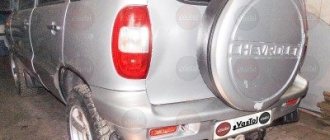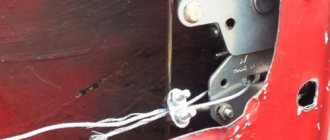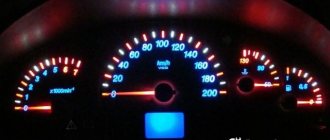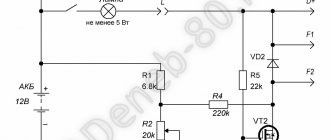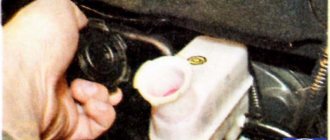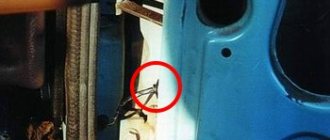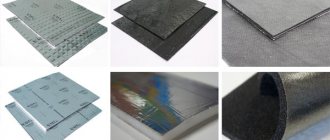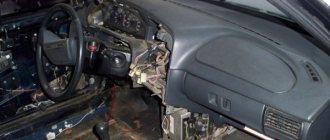Owners of serviced car batteries need to regularly monitor the level of electrolyte in them and, if necessary, add pure H2O, free of minerals and organic additives. This water is called distilled and is an important component of the battery fluid. Its task is to maintain the chemical composition of the electrolyte at an optimal level, thereby guaranteeing high-quality battery operation.
Before you find out how to properly pour purified liquid into the battery, it is important to remember that it is prohibited to use tap or boiled water for this purpose. They contain a lot of foreign impurities (iron, calcium, magnesium, chlorine), which are deposited on the metal plates of the battery during charging. This “scale” leads to a decrease in battery capacity and destruction of its plates. This changes the density of the electrolyte in the battery.
Where can I get distilled water?
Car owners can buy deeply purified water in a five-liter bottle or other container at a hardware store, supermarket (in the household appliances department), pharmacy or at a gas station in the auto cosmetics department; these outlets are supplied by trusted suppliers. The largest manufacturer and supplier of distilled water is. You can order and buy distilled water on this page. You can also get it in normal home conditions, using one of the traditional methods of cleansing.
The first method is evaporation. For it you will need a large saucepan that closes tightly with a lid, a glass container and a metal grid. A wire rack is placed in the pan and then filled halfway with plain water. The glass container is placed on the grill so that its neck rises above the water. The pan is tightly closed with a lid and put on gas. Ice is placed on top of it. The water boils, condenses on the cooled lid and is collected in a glass container.
The second method is freezing. To do this, running water is poured into a plastic bottle and placed in the freezer. After half the liquid turns into ice, the unfrozen water is drained from the bottle and the remaining ice is melted. This is the distillate.
And the easiest way is to collect rainwater, which is a natural distillate. True, in large cities it has too high a percentage of acidic impurities, which makes it unsuitable for use in a battery.
What kind of water should I fill?
Now let’s talk about whether it’s possible to fill with water. Obviously, it should not be from the tap, but only distilled without any impurities. Its level inside the battery is not constant; it tends to evaporate due to high temperatures or charging the generator. It turns out that the acid level begins to rise, because it does not evaporate. Only water decreases, and this helps to increase the density of the concentrate. As mentioned above, the process negatively affects the condition of the plates - even sulfation can occur.
Adding water will avoid all these problems. You just need to do this strictly according to the level so that you fill no more than the norm. The distillate is sold in auto shops, pharmacies and even ordinary hardware stores. You can prepare such a liquid at home. True, you need to build a small plant: a kettle with a high spout, a saucepan, a container for collecting condensate. Some take distillates from hospitals and laboratories where a steam boiler room operates.
Signs that the battery requires refilling with water:
- the battery is very hot;
- steam comes out of the filler holes;
- There is condensation on the housing.
Correctly pour distilled water into the car battery
The service life of the car battery and the serviceability of the car’s electrical network depend on how correctly we pour the distillate into the car’s battery. By maintaining the sequence of actions, we thereby extend the life of the battery.
1. Place the battery strictly horizontally. Otherwise, you will either overfill the water or not add it due to the fact that there will be different levels of liquid in the jars.
2. Wipe the surface of the battery around the edges of the plugs to remove any dirt.
3. Dip a rag in the soda solution and wipe the necks of the jars with it to neutralize the sulfuric acid that has accumulated there during the charging process.
4. Unscrew the caps, trying to prevent electrolyte from getting on your hands (it is better to wear gloves).
5. Fill a small rubber bulb with purified water and carefully pour it into each jar.
6. Inspect the electrolyte level in the jars - the battery fluid should be 1 cm above the top edge of the plates.
7. Simply remove excess liquid with a pear in the required volume.
8. Screw on the caps.
9. Charge the battery no earlier than after 3-4 hours.
How to add distilled water to a car battery correctly
If the density of the electrolyte in your battery has increased or you notice that it does not produce the required voltage, most likely the reason is a decrease in the amount of distilled water. Normally it should be 65% to 35% sulfuric acid.
Sequence of work when adding distillate to the battery.
To correctly add liquid to the jars, use the instructions.
- Remove dirt and dust from the top of the battery, especially around the plugs.
- Wipe the area around the necks with a rag soaked in soda solution to neutralize any sulfuric acid that may have splashed out during charging.
- Carefully unscrew the plugs - protect your hands from exposure to electrolyte.
- Take a medical syringe, syringe or hydrometer and fill with distilled water.
- Pour liquid into jars with insufficient electrolyte levels.
- Tighten the plugs.
- After 2-3 hours, check the density of the electrolyte with a hydrometer (normal value in the table below).
- If everything is done correctly, put the battery on charge.
Adding distilled water to the battery should be done on a horizontal surface. Otherwise, the level of liquid in the jars will be different, so you will either overfill or underfill.
The recommended battery electrolyte density depends on the climatic conditions of your region.
Climate zone
Electrolyte density (g/cm 3 )
To ensure accurate results when measuring the density of the electrolyte, hold the hydrometer vertically and do not allow the float to touch its walls. Having collected the electrolyte into the flask, gradually reduce the pressure so that the float floats freely. If you were able to achieve this, pay attention to the place where the liquid comes into contact with the scale. This will be the density of the electrolyte in the battery.
Check the density of the electrolyte after adding distilled water to the battery.
How much distilled water should be added?
The batteries of new models, made of translucent plastic, are quite easy to add water to. On their body there is a scale with the manufacturer’s recommended liquid level, which must be adhered to. The situation is more complicated with older type batteries. Here are some tips to help you cope with the task. If your battery has a small tongue below the neck of the cans (metal or plastic), then water should be added until the electrolyte level rises 5 mm above it. If there is no tongue, then you need to add distilled water until the electrolyte level rises 1 cm above the top of the plates.
How to check the level and how much to add
There is a special device designed to determine the level of required concentration of the mixture in the device - a hydrometer. The object is dipped into the solution, and then the concentration of the substances is checked. During operation, the device should not come into contact with the glass walls, which is why it is held in a vertical position in front of you.
If the readings are high, it is recommended to add the required amount of water to the device. It's easy to see when and how much liquid to add by looking at the lead plates. If the substance does not completely cover them, distillate is added to the battery in such an amount that the composition completely covers the sheets.
Important! In modern models of devices made of plastic, distillate is poured according to a scale drawn on the body of the model. It is necessary to adhere to the marked level.
It is imperative to add a water component, especially when the device shows high density indicators of the composition. If you ignore the problem, the battery may overheat. Consequently, a breakdown will occur. If the car owner does not systematically add fluid to the battery, the amount of acid in it increases and the battery lasts much less.
With old batteries, things are a little more complicated. As a rule, the battery must have a special “tongue”. Water must be added to the battery until the electrolyte level is 5 mm above it. If there is no “tongue”, then add until the mark is 1 cm higher than the top of the plates.
It is prohibited to add a component to an autonomous power source in a car if the engine has just been turned on. It is important to let the battery sit for at least a couple of hours before opening it. After adding this component, you cannot immediately turn on the internal combustion engine. The battery needs to sit for a while, otherwise it will boil.
Electrolyte
As you and I know, the electrolyte (inside the battery) consists of two main components:
- This is sulfuric acid. Its approximately 35% of the total volume
- Distilled water. Its approximately 65%
When these two substances are mixed, the electrolyte needed for work is obtained, with a density of 1.27 g/cm3. It is not recommended to add more than 35% acid; if you raise the density to 1.3 - 1.4 g/cm3, then at this concentration the lead plates will suffer and may collapse prematurely.
However, it is also not recommended to pour less acid; a reduced density of 1.2 - 1.23 g/cm3 can contribute to the freezing of the electrolyte at extremely negative temperatures (-25, -35 degrees).
That is, this density has been verified by many experiments and is a reference; it is worth noting that in the north up to 1.29 g/cm3 is allowed
How much and how to pour distilled water into the battery
At the very beginning of the article, we already noted that a low level of electrolyte in battery banks can lead to destruction of the lead plates, so the electrodes cannot be dry, they are completely filled with solution. But the water level must be certain, 10-25 mm above the upper edge of the plates (depending on the battery model and the manufacturer’s recommendations), any deviations from the norm in any direction lead to undesirable, and sometimes even disastrous consequences:
- if there is not enough electrolyte in the battery, the battery quickly runs out, often fails completely, and the battery may even explode under load;
- if the level is too high, the required density is not achieved (the standard is 1.27 g/cm³), liquid begins to come out of the cans, and oxides appear on the body and terminals.
Water inside the battery
How we figured out water AJ - 65%! But it is not simple (from the tap) , but distilled without any impurities (this is necessary for many reasons, if only because the resistance inside decreases, there is no sediment on the plates, etc.).
But its level is not constant. As is known from high temperatures in the engine compartment, from charging the generator (sometimes overcharging ), water can evaporate from the cans, and the electrolyte level drops.
Sulfuric acid does not evaporate, and therefore its concentration begins to increase; this is bad for the battery in several ways:
- High density negatively affects the plates, destroying them
- The level drops, which means the plates are exposed, thereby reducing the battery capacity and it is not able to start your car.
- At high acid concentrations, sulfation of the plates
To avoid this, you must replenish it - add water inside the battery to the required minimum.
Why do you need to add water to the battery?
It would seem that the battery in a car should be untouched throughout its operation, since this chemical power source for the car contains sulfuric acid, which is very toxic.
No sane motorist would open a battery that contains sulfuric acid, lest he be poisoned by its fumes or get his hands burned.
But experienced motorists understand that the sulfuric acid in a lead-acid battery is in a diluted state, and you can open the battery cover without fear, much less add water. But why should you add water to the battery?
There are a number of reasons for this:
When the engine overheats, high temperatures cause the water in the lead-acid battery to evaporate. This will cause battery performance to deteriorate.
Water also helps to cool the battery , so it is worth constantly replenishing it.
Water, together with sulfuric acid, acts as an electrolyte, that is, a conductor of electrons, and if there is an imbalance in the amount of one of the electrolyte ingredients, then electrons will not circulate freely in the battery and electrical conductivity will deteriorate sharply.
Thus, it is imperative to replenish the water reserves in the batteries , otherwise the battery will very quickly become unusable.
How to add water to the battery?
First, let's look at the serviceable option - when there are plugs on top of the battery. Everything is elementary here:
First , you need to buy distilled water in a store or make it yourself at home .
Second , just unscrew the plugs on top and look at the plates. If they are bare, the electrolyte level is lower, you need to add so that the water covers them. I’ll tell you how much to pour below.
Third , after adding it, put it on charge; you can use automatic chargers
As you can see, everything is elementary - there are no problems.
How to add distilled water to a battery
The battery is probably one of the most important parts of a car's equipment. She is responsible for starting the engine in all conditions, for all electrical components and devices. On injection engines, the condition of the ECU (electronic engine control unit) also depends on the correct operation of the battery. with electronic fuel injection, the battery evens out voltage surges that occur during generator operation.
You will need
- Distilled water, syringe, glass tube with a diameter of approximately 5mm, charger from 0.05-1.5A.
Instructions
1. First you need to measure the electrolyte level. To do this, you need to unscrew the plugs on the top surface of the battery (a wide screwdriver will work perfectly), insert a glass tube the size of a ballpoint pen into one of the compartments and plunge it to the bottom. Cover the top hole of the tube with your finger and pull it out, the level of electrolyte in the tube is equal to the level in the battery (the norm is 13-15 mm), if it’s higher, then you should suck out the unnecessary electrolyte with a syringe, if it’s lower, it’s time to add distilled water. 2. Suck clean water into the syringe and add 5-10 ml to each of the six segments of the battery. Thus, achieve the required level of electrolyte in the battery. 3. Take a special charger and connect it to the battery without closing the plug. This is necessary if there is too much electrolyte, it will have somewhere to leak. First, charge and discharge the battery 3-4 times to correct the capacity. Then set the current on the charging device to 0.1A and monitor the voltage at the terminals. It is impossible to allow the battery to boil or overheat; if necessary, reduce the charging current. Typical voltage when fully charged should be 13.9-14.5V. Then reduce the current to 0.05A and continue charging. If over the next 2 hours the voltage remains unshakable, stop charging! 4. Close the lids. For greater reliability, leave the battery for approximately 12 hours. Then start using it. The battery is ready to go!
Despite the fact that modern industry produces maintenance-free batteries, checking the electrolyte in the battery and making sure of its quality will not be superfluous for anyone.
You will need
- Glass tube with a diameter of 5 mm,
- hydrometer.
Instructions
1. One of the tasks when checking the electrolyte will be to freeze its layers in the entire jar. In order to complete the task, you need to pull off the packaging film and unscrew the caps in the entire jar. After this, a glass tube is taken in hand and one end is immersed in the electrolyte, reaching the separator, the upper hole of the tube is tightly closed with a huge finger, and in this state it is removed from the battery jar.
2. If the electrolyte level in the battery is normal, then the tube should be filled at least 10 mm. In cases where the tier is unsatisfactory, the similar is considered a factory defect. 3. At the next stage, the density of the electrolyte poured into the battery is checked. To achieve the goal, we take a hydrometer in our hand and use it to sample the electrolyte one by one from the entire battery can. If it is discovered that the density of the electrolyte in the battery banks does not correspond to the norm or it turns out that it is below 1.27 units, then such a battery should not be purchased.
Note! For the southern regions of Russia, electrolyte with a density of 1.25 units is poured into batteries. And we also need to consider that a decrease in the density of the specified solution by one unit indicates a battery discharge of six percent. And if the battery in a trading organization is discharged by 10% or more, then such a battery is also considered defective.
When batteries “boil”, the tier falls and the density of the electrolyte increases. If the necessary measures are not taken in a timely manner, the battery will lose its capacity over time. You can restore these indicators by adding water to the battery.
You will need
- distilled water
Instructions
1. Clean the surface of the battery Cleaning the surface of the battery is necessary for several reasons. Firstly, the surface may be contaminated by splashed sulfuric acid, which is dangerous for the worker and his clothes, secondly, the contamination can get inside the battery and lead to its damage, and thirdly, it is better to work in a clean environment. To clean the surface, wipe thoroughly with a damp cloth, preferably moistened with a solution of baking soda. The recesses on the top cover, exclusively around the plugs (or filler holes), are easier to clean using a match. 2. Add water Only distilled water is allowed to be added to those jars where the electrolyte level is below the minimum mark. This can be determined in translucent batteries by the “risks” on the sides of the case. Tides are visible inside the filler holes, marking the upper and lower tiers. If there are no marks, then you should focus on a tier above 10-15 mm above the top of the plates. It is best to add water to the battery using a rubber bulb, a large medical syringe, or using an aerometer (more precisely, an external flask) to measure the density of the electrolyte. 3. Measure the density of the electrolyte The density of the electrolyte is not restored immediately after adding water. This is due to the fact that in a battery there are small intervals between the plates, and mixing of liquids occurs very slowly (sometimes the density evens out after a few weeks). Consequently, after adding water, the battery needs to sit for several hours. Only then will density indicators approach real ones, and it can be measured. To accurately determine the density, you need to take several measurements at equal time intervals. And if the difference between the current and previous measurements is insignificant, the battery is ready for use after recharging.
The charger can charge the battery with an approximately constant current or dynamically change it as the capacity progresses. Switching on the ammeter in stages with a battery, even with very low internal resistance, can disrupt the charging mode. A special contactless device will come for support.
Instructions
1. The device you need can be called differently: clamp meter, non-contact ammeter, current clamps, etc. All these names are synonyms. Choose a clamp meter in which the element that responds to the magnetic field created by the current-carrying conductor is not an inductor, but a Hall sensor. It differs from the coil in that it reacts not only to an alternating field, but also to a continuous field, which means that current clamps with it are capable of measuring continuous current using a non-contact method. 2. Using the limit switch on the device, select the range that best matches the required charge current. Its approximate value is indicated in the instructions for the charger or directly on the body of the latter. Press the clampmeter lever and the halves of the magnetic circuit will separate. Place between them one of the conductors through which the charging current passes. Do not place both conductors at once, since then their fields will cancel each other out, and the current clamp will show zero even with a significant current. 3. Close the magnetic circuit and turn on the charger. You will immediately see the current value on the indicator. Start the stopwatch at once. Enter the readings of both instruments into the table. Divide the duration of the charge cycle specified in the instructions for the charger into several intervals and continue to record the readings of both devices in the table exactly at this frequency. 4. When the charge is complete, turn off all devices, including the charger itself, disconnect the battery, and then plot the charge current versus time. For time, select the horizontal coordinate, and for current strength, select the vertical one. If you now show this graph to an expert, he will be able to say a lot both about the literacy of the charge algorithm chosen by the device , and about the state of the battery itself. It is possible that the end needs to be replaced or corrected using special equipment. Note! Do not short-circuit the battery. Please note that some chargers are designed using a transformerless circuit; therefore, do not touch the terminals while charging. Note! When servicing your battery, you cannot forget about your own safety. Basic precautions must be strictly observed. The battery contains sulfuric acid and flammable detonating gas; when working, keep away from open flame sources. Helpful advice During operation and maintenance of the battery, it is best to wipe its surface with a cloth soaked in ammonia or a solution of water and baking soda. It helps extremely effectively when electrolyte gets on the surface of the battery.
Maintenance free battery
But if you take a maintenance-free battery (for example, BOSCH, VARTA, MUTLU and many others), then you won’t be able to add it here so easily. The design does not provide for adding water inside, that is, you will have to “chemically” it.
To be fair, it is worth noting that often maintenance-free batteries are made using calcium technology and their water loss is very small. However, after 4–5 years the level still drops and it is advisable to bring it to normal
BY THE WAY - many of these batteries are handed over to specialized stores when they no longer start the car and they buy new ones. BUT NOT MANY people know that you just need to add water there and then performance will be restored.
HOW TO ADD, STEP-BY-STEP INSTRUCTIONS:
- First, determine the electrolyte level. Lightly shake the battery left and right, if there is a minimum level, then you should add water. If there is a feeling that there is enough of it there, then perhaps water will not help you (maybe you have shedding or sulfation)
- We determine where your plates are located (at what height). If the battery is transparent (has a white casing, like BOSCH's), you can illuminate it with a flashlight. But if the body is black, then it won’t work out that easily, you have to figure it out “by eye”
- We retreat from the plates approximately 1.5 - 2 cm upward. We take a 2-3 mm drill and drill small holes.
- Take distilled water and a syringe with a needle. Fill the syringe and pour it into the battery through the holes
- It is worth adding before liquid begins to ooze through the holes.
- Then we put the battery on its side and solder the holes with a regular soldering iron.
- Then we just charge
You have to “collective farm”, there is no other way. Some people drill holes from the top, but this way it is impossible to control the level (and you also cannot overfill).
How to check the quality?
Before using distilled water obtained at home for the battery, it must be tested for purity.
To do this, use the following method:
an electrical circuit is formed from a light bulb and a battery with contacts between them;- the ends of the wires are lowered into the resulting distilled water, leaving a gap between them;
- If the water for the battery is of good quality, the light will not light up, since the distillate without impurities does not conduct electricity.
To check the operation of the electrical network, you need to add table salt to the liquid. Its appearance in water will increase electrical conductivity, and the light bulb will light up.
You can use special strips impregnated with an indicator, which are sold in a specialized store. The pH of distillate is 5.5-6.6, and that of ordinary water is 7.0-7.5.
We recommend an article on the topic
Basic ways to check the quality of distilled water
How much water should I add to the jars?
Another important condition. Some batteries have a special level (usually on the side of the case) to which you should add water (you cannot overfill).
However, a large number of batteries do not have this level, so how much should you pour?
ONE very simple rule. The plates must be covered with electrolyte by 1 - 1.5 cm (measured with special measuring tubes). At this level, a density of 1.27 g/cm3 is obtained
You shouldn’t pour more, otherwise the density will drop to 1.20 - 1.24 g/cm3 and there is a high probability that the battery may freeze in winter.
Now let's watch a small but useful video.
This is where I end, I think my article was useful to you. Sincerely yours, AUTOBLOGGER
( 7 votes, average: 5.00 out of 5)
Similar news
Battery polarity is forward and reverse. What is it and what kind.
How much electrolyte is in the battery? Let's look at the volumes of options from.
The terminal on the battery, positive or negative, gets hot. When starting
Car batteries, as well as some other batteries, require a special sulfuric acid solution for normal operation.
Due to it, the recovery process is carried out after the battery is discharged. Distilled water needs to be added periodically.
ATTENTION! A completely simple way to reduce fuel consumption has been found! Don't believe me? An auto mechanic with 15 years of experience also didn’t believe it until he tried it. And now he saves 35,000 rubles a year on gasoline! Read more"
How much distilled water should I add to the battery?
In a modern battery, the easiest way is to understand how much distilled water needs to be filled. Its body is made of transparent plastic with a scale printed on it. It is enough to ensure that the level recommended by the manufacturer is not exceeded.
If you have a different type of battery, use the following tips.
- In some batteries, metal or plastic is located just below the neck of the can. The electrolyte level should be 5 mm above the “tongue”.
- If there are no marks in the jar, add distilled water so that the electrolyte level is 10-15 mm higher than the lead plates.
- If you cannot visually determine how much electrolyte is in the jar, take a glass tube, lower it into the compartment, pinch the top with your finger and carefully remove it. The amount of liquid in it will be equal to the distance from the lead plates to the surface of the electrolyte.
Is it possible to add water to a car battery and what kind?
It is important to remember that the liquid used is not ordinary water, but purified from foreign inclusions. This means distillate. It should be free of salts and other foreign components. This is what makes ordinary water a conductor. Purified water, devoid of any impurities, is a dielectric.
The liquid present inside the battery is 65% ordinary water.
We must remember: the electrolyte level must be constantly monitored. If it has decreased to a certain level, then it must be topped up.
But first decide what exactly to fill: distilled water or sulfuric acid (electrolyte).
There are only two reasons for the level drop:
- the battery case is damaged - the electrolyte gradually leaks out of it;
- the liquid evaporates.
Moreover, the second case requires “investigation”. Since boiling of the electrolyte serves as a signal of a malfunction of the battery itself or the generator. Only after repairs have been carried out should refilling be carried out. Only special formulations should be used - ordinary tap water should not be used.
What does battery fluid consist of?
The electrolyte consists of two main components. This is water and sulfuric acid. There is more distilled water - it occupies about 65% of the total internal volume. This mixture optimally provides a composition density of 1.27 g/cm3. If the acid is more than the norm of 35%, the density will rise to 1.3-1.4 g/cm3. At this concentration, the lead plates of the battery gradually deteriorate.
You should not fill it with less than 35%: in this case, the density will decrease, which will lead to freezing of the liquid in the winter season. Thus, water and acid in the battery must have specific proportions, they cannot be disturbed.
Electrolyte density within 1.27 g/cm3 is an average value. To find out the specific value, you need to check the table of climatic zones and density.
| Climatic zone with average winter temperatures | Electrolyte density in a fully charged battery |
| Far North from -50 to -30 | 1.29 |
| Northern zone from -30 to -15 | 1.28 |
| Central zone from -15 to -4 | 1.26 |
| Southern zone from -15 to +4 | 1.24 |
| Tropics from +4 +6 | 1.22 |
Is it possible to add electrolyte?
The electrolyte is a special composition including water and sulfuric acid in the following ratio:
- sulfuric acid – 35%;
- distilled water – 65%.
The standard density, which allows all reactions to occur inside the battery in normal mode, is 1.27 g/cm 3 . It must be remembered that it is not allowed to add more than 35% acid to the composition. Since this affects the charging speed, as well as other qualities.
For example, with an electrolyte density of 1.4 g/cm 3 it can cause serious trouble - the plates will be damaged and gradually crumble. But it is also not recommended to pour a smaller amount of acid. Since the liquid inside the battery will simply freeze at negative temperatures. It should be noted: the required density is a reference. It is not recommended to underestimate or overestimate it.
You need to top up correctly: when it boils during chemical reactions, it is water that leaves the battery. In this case, the amount of sulfuric acid in mass terms remains the same. To maintain the 35%/65% ratio, it is necessary to fill it with distilled water purchased in special stores. You should not use regular, boiled one for these purposes - the battery will simply fail as a result of a short circuit in the cans.
The process of adding liquid to jars is not technically difficult, but it requires care and caution. Sulfuric acid poses a serious threat to human life and health. It is advisable to avoid leakage. It can lead to serious problems - burns. Top up should be done in a well-ventilated area.
How much electrolyte should be in the battery
Battery electrolytic fluid is characterized by two indicators:
The car owner must maintain both the electrolyte level in the battery and its density. This does not require any special knowledge and/or tools.
Dependence of the volume of an aqueous solution of sulfuric acid on the battery capacity
If it is necessary to clarify how much electrolyte should be in the battery, the motorist first needs to find out what capacity his battery has. This will directly determine how much fluid should normally be inside in liters.
Currently, the Russian market offers batteries ranging from 55 A * h and up to 190 A * h. The most widespread are batteries with a capacity of approximately 60 A and up to 70 A.
Here is a table of the dependence of battery capacity on the nominal level of an aqueous solution of sulfuric acid:
Battery capacity, in A * h
Amount of solution, in liters
10 or more (depending on the specific battery model - Beast, Mutlu, Exide, etc.)
How to check the level
On certain types of car batteries, “Min” and “Max” marks are placed on the plastic case, by which the car owner can monitor the electrolyte level. The liquid must be within the boundaries of the specified marks.
However, in practice, measuring the volume of liquid inside the battery in the presented way is problematic - due to the fact that the battery case is opaque. It is also not very convenient to look inside the cans through open lids and correlate the current level with these marks.
Therefore, it is recommended to measure differently - in one effective way:
- take any glass tube with open (not sealed) ends at the top or bottom - for example, a transparent ballpoint pen body or a fruit juice tube is perfect;
- the lids (plugs) of the battery cans are opened;
- This improvised meter is inserted into each jar one by one until it touches the lead plates;
- the upper end of the juice tube or the body of a ballpoint pen is clamped with a finger;
- the device is removed;
- Some of the liquid will remain on the tube - you need to measure how much there is - with a ruler or construction tape.
The driver’s further actions depend on whether the actual amount of liquid is smaller or larger:
- if there is a reduced amount of electrolyte in the tube, it means that there is not enough of it inside the battery - accordingly, it is necessary to add either distilled water or electrolytic liquid (which exactly, see below);
- if, on the contrary, there is more than 1 - 1.2 cm of liquid in the tube, then the aqueous solution of sulfuric acid in the battery is more than normal, which means that it needs to be pumped out (see also below for how to do this).
In maintenance-free batteries there is no access to the banks, so it will not be possible to check the level of the solution in the presented way. The performance of such batteries is checked:
- by color charge indicator;
- or by marks on the body.
When should you add water and how much?
It is important to constantly monitor the electrolyte level in the jars: not only high, but also low is dangerous. The battery case is usually equipped with a special level - the electrolyte must differ up or down by 1-2 mm. Accordingly, at a lower level, the density will increase significantly - which leads to gradual sulfation of the plates. In the long term, this leads to their complete destruction.
At increased levels, the density of the electrolyte decreases. As a result, the liquid can simply freeze at subzero temperatures. The consequence of freezing is hardening of the composition and breakage of the plastic case from the inside. It must be remembered: the danger of this situation is that in the summer there are usually no problems with this. But in winter, the distillate will set already at -20/-30 0 C.
Therefore, if you find half-empty cans in the battery, you urgently need to add distilled water. Regular use is contraindicated. Its presence will lead to a short circuit.
Why can't you add undistilled water?
Many drivers are interested in whether it is possible to fill the battery with ordinary water. Yes, this would make life easier for drivers, but to solve this issue, pure H2O is required. It can be obtained by purifying the liquid by double evaporation and collecting the condensate. Thus, foreign salts, minerals and other unnecessary substances are removed from the water. You can constantly add such liquid to the battery, since condensate, when it evaporates, does not form sediment. And if you fill the battery with ordinary water, the following problems may arise:
- sediment will appear on the plates, leading to their destruction, an increase in resistance, and also a decrease in capacity;
- electrical conductivity will change;
- self-charging will accelerate, which will result in an increase in the density of the working mixture.
Important! You can buy special distilled water at car dealerships and gas stations. But even here there are fakes . Therefore, it is very important to study the label and become familiar with its information. But it is better to measure electrical resistance using a tester. If there is no impurity in the liquid, this indicator will be infinite, and if there are impurities, the device indicates a specific number.
How to fill water correctly
The pouring process is relatively simple and does not require special equipment. You will need to prepare the following:
- gloves – resistant to the destructive effects of sulfuric acid;
- special funnel – it allows you to avoid spilling liquid when adding;
- glasses to protect your eyes - contact of sulfuric acid with the mucous membrane can cause serious problems.
When everything is ready, you can proceed directly to topping up:
- unscrew the plugs;
- inserts a funnel;
- Carefully add distilled water to a certain level.
You need to remember: if there is more liquid than needed, it should be removed using a special bulb. You can buy it at any car store. The main condition is that the material must be resistant to acidic environments.
What is distilled water and why is it needed in a car?
Distilled water is water purified by distillation that does not contain organic or mineral compounds. There are no metals, mineral salts or other impurities in such water. This is a pure product, the components of which are only some atmospheric gases, such as argon, nitrogen, oxygen and carbon dioxide. But in order for water to become a completely neutral medium, it can be heat treated (boiling). It is due to these qualities that distilled water has very low electrical conductivity, which allows it to be used to service many vehicle systems.
Typically, distilled water is used for:
- Dilution of battery electrolyte. If during operation, part of the electrolyte boils away, it is replaced with distilled water. This method can extend the battery life.
- For diluting highly concentrated liquids, for example windshield washer antifreeze.
- For cleaning oil filters when changing engine oil. Since distilled water is a neutral medium, it is practically not capable of causing corrosion of metal elements.
- To cool the radiator. Quite often, it is distilled water that is poured into the radiator, and not antifreeze.
As you can see, distilled water has a wide range of uses. Buying it will not be difficult, since there are many different manufacturers on the market.
How to fill a maintenance-free battery with water
Typically, a maintenance-free battery does not require fluid to be added. Calcium technology is used in production - water loss is minimal. But after 5 years it will be necessary to add distillate. The process of adding fluid to a maintenance-free battery:
- you need to determine the electrolyte level - to do this, just swing the battery from side to side;
- we find out at what height the plates are located - this can be done with a flashlight (enough to illuminate the body);
- you need to move upward from the plates by about 2 cm - after which a hole with a diameter of 8 mm is drilled;
- Using a regular syringe and needle, liquid is added.
The process of pouring liquid into the battery case does not pose any serious problems. It is only important to maintain the level.
How to make your own distilled water?
Making distilled water at home is difficult, but possible. More precisely, the process itself is not so complicated as it is lengthy. There are two methods for making distilled water yourself: boiling and freezing.
The procedure for obtaining distilled water by boiling is as follows:
- A stainless steel pan is filled with water, tightly closed with a lid and boiled for 30 minutes. The lid should be as tight as possible so that the percentage of water evaporation is insignificant.
- Then, the water is poured into a clean container, allowed to cool and settle (about 1 hour).
- Next, the settled water (without sediment) is again poured into the pan and boiled.
- After the water that has boiled for the second time has cooled and settled, it is poured into a clean, sterile container (jar), without sediment, and tightly closed with a sterile lid.
This is a simple distillation method, but, unfortunately, such water will still contain minor impurities of mineral salts. It is recommended to use it for diluting concentrated substances and nothing more. To obtain distilled water using the freezing method, you need to fill a sterile container with water and place it in the freezer. The freezer should not contain any food, otherwise it will affect the quality of the water. Prepare additional sterile containers (jars).
During the crystallization process, pure water begins to freeze first, and water with impurities remains in a liquid state. You need to collect all the frozen water and place it in a prepared container so that it melts there. This procedure is carried out several times until the required amount of water is obtained. Water prepared in this way can be used to refill the battery and cool the radiator. As you can see, even at home, without any difficulties, you can get high-quality, purified distilled water, while saving your money!
Share:
